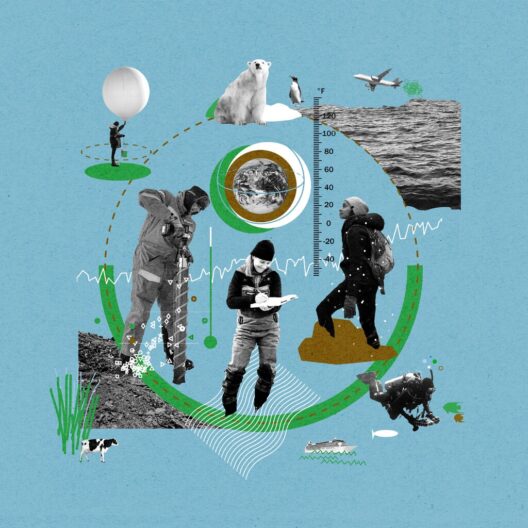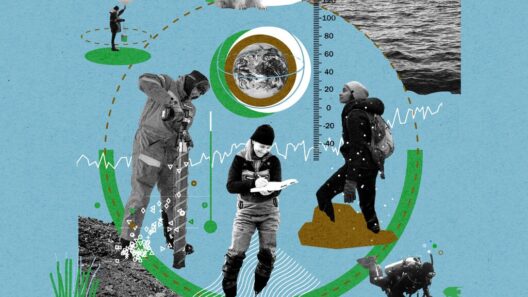As the planet becomes increasingly susceptible to the relentless march of climate change, indicator species serve as the bellwethers, revealing the looming threats to ecosystems and humanity alike. Among these harbingers of environmental extremes are the ice-dependent species, whose plight significantly underscores the catastrophic impacts of global warming. What happens when the very foundations of their world—the ice—begin to vanish? This alarming transformation not only portends dire consequences for biodiversity but also mirrors the broader ramifications of climate change that we must address with urgency.
First, let’s delve into the concept of indicator species. These organisms reflect the health of their ecosystems, acting as vital barometers for environmental changes. For instance, polar bears, seals, and certain species of fish rely extensively on ice-covered regions for their survival. As the Arctic ice retreats due to rising global temperatures, these creatures face existential threats. Without sea ice, polar bears struggle to hunt seals, their primary food source, as they lose essential platforms for hunting and reproduction. This cascading effect is a microcosm of the larger climate crisis: the melting ice is not merely a visual symptom but a clarion call that signals deeper disruptions within the ecosystem.
But what does melting ice truly indicate about the state of our planet? The implications are multifaceted. First, ice melt contributes to rising sea levels, an alarming trend that threatens coastal communities worldwide. As Arctic and Antarctic ice caps diminish, the consequent influx of fresh water alters oceanic currents and increases salinity levels. This leads to widespread environmental changes that can result in the destabilization of marine habitats. Imagine a world where entire communities are engulfed by floodwaters, and marine species struggle to adapt to rapidly changing conditions. The threat is not confined to polar regions; it is an unfolding global crisis that unravels the interconnected fabric of life.
Moreover, melting ice reveals the perils of methane release, a potent greenhouse gas trapped in permafrost. As temperatures rise, this thawing accelerates methane emissions, exacerbating climate change and creating a vicious feedback loop. It poses the question: what are we doing to confront this potential disaster? The challenge isn’t merely scientific but societal. We must recognize that our societal infrastructure—transportation, agriculture, and energy production—is inextricably linked to the state of the environment. As indicator species suffer, so too do the systems upon which human existence relies. The urgency to reduce greenhouse gas emissions cannot be overstated.
But why should we care about the plight of these indicator species? Beyond the emotional and ethical arguments, there lies a pragmatic reality. The degradation of ecosystems jeopardizes food security, health, and livelihoods, particularly for those communities already vulnerable to climate impacts. Take the example of Indigenous peoples in the Arctic, whose cultures and ways of life are deeply intertwined with the ice. The disappearance of ice erodes not only their physical environment but their cultural identity. It poses a challenge for us all: how do we ensure that the voices of those most affected by climate change are heard in the global discourse?
So, how can we act to mitigate these effects? An effective approach requires a combination of policy reform, scientific innovation, and grassroots activism. Policies aimed at reducing carbon emissions, promoting renewable energy, and conserving biodiversity are vital. Moreover, public awareness and education play a crucial role in fostering a culture of sustainability. Each of us has the power to make choices that positively impact our environment. Whether through advocating for climate-friendly practices or supporting legislation aimed at protecting vulnerable ecosystems, active engagement is essential.
In addition to policy reforms, the scientific community continues to explore innovative solutions to address the challenges posed by climate change. Technological advancements, such as carbon capture and storage, and innovations in sustainable agriculture, hold promise. However, these advancements necessitate public investment and support. It begs the question: how committed are we to transitioning toward a sustainable future? This is a call to collective action, urging individuals, businesses, and governments alike to embrace sustainable practices that prioritize both environmental protection and economic viability.
As the evidence mounts and the clock ticks, the role of indicator species becomes ever more critical. They serve as a poignant reminder that the impacts of climate change are not distant specters but immediate realities demanding our attention. Melting ice stands as an emblem of the broader environmental crisis, echoing the need for comprehensive action. The fate of many species hangs in the balance, but so does our future. What legacy will we leave for generations yet to come? Will we stand idly by as the indicators signal alarm, or will we rise to the occasion and forge a sustainable path forward?
The intersection of climate change and its ecological ramifications raises essential philosophical and practical considerations. We must ask ourselves: how do we balance human development with the need to protect fragile ecosystems? As stewards of this planet, it is our collective responsibility to ensure that the melting ice of today does not spell the doom of the myriad life forms that rely on it. By addressing these challenges, we honor not just the environmental indicators but the interconnected web of life that sustains us all.







